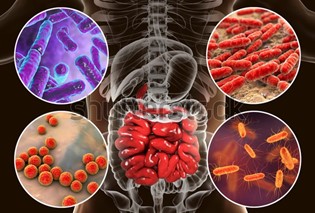
When we think about someone with ADHD, we don’t automatically think about what’s living in his or her gut. Still, recent research has shown that there might be some differences between the gut bacteria of adults with ADHD, compared to those without ADHD. This can help us to better understand what causes ADHD, and develop new treatments.
Attention deficit/hyperactivity disorder (ADHD) is a neurodevelopmental disorder that involves symptoms of inattention, hyperactivity and impulsivity (1,2). Due to these symptoms, someone with ADHD may experience problems at work, school and/or family or personal relationships (3). ADHD is quite a prevalent condition, affecting approximately 5% of children, of which 50 – 70% keep their symptoms in adulthood (4).
Among the causes implicated in ADHD are genetic factors but also environmental factors (factors that are not in your genes, but come from ‘outside’, such as smoking during pregnancy). Both genetic and environmental factors seem to be involved in the fact that individuals with ADHD seem to have differences in their gut microbiota (5,6).
The gut microbiota is the set of microorganisms that live in our gut and have a beneficial impact on a person’s health. The human gastrointestinal tract contains microbiota of more than 10 14 bacteria, yeasts, fungi and viruses (7). The amounts and types of bacteria that live in your gut depend on many different factors. These include your own genes, but also environmental factors such as diet and environmental exposure to microorganisms. When there is a bacterial imbalance in your gut this can negatively influence the functioning of the brain through several intertwined pathways that together form the ‘gut-brain axis’ (8).
Recent scientific studies have tried to find out what differences exist between the composition of the gut microbiota of individuals with and without ADHD. The results have shown that people with ADHD contain different bacteria in their gut. These bacterial species have difficult, unpronounceable names, such as Gracilibacteraceae (adults with ADHD had less of these), Selenomonadaceae and Veillonellaceae (adults with ADHD had more of these) (8). Whether it’s a good or bad thing to have more or less of these bacteria is not yet fully known, so more research is needed to fully understand these findings.
Even though we don’t fully know all the bacterial species that live in our gut, and what makes a ‘healthy’ balance, these findings are still an important step in better understanding ADHD. The results of this study may help to characterize the gut microbial ecosystem of individuals with ADHD, help to define the microbiome-gut-brain connection pathways, and provide biomarkers implicated in this disorder, allowing more specific targets for treatment to be established (8). In addition, the relationship between microbiome and diet would allow researchers to create new theories on how certain nutrients impact ADHD and to develop new nutritional interventions to reduce symptoms and improve quality of life (8). That is exactly what we’re currently investigating in the Eat2beNICE project, so keep following this website for updates!
References
1. Faraone, S. V., Asherson, P., Banaschewski, T., Biederman, J, Buitelaar, J., Ramos-Quiroga, J.A., et al. (2015). Attention-deficit/hyperactivity disorder. Nat Rev Dis Prim, 1,15020. Doi:10.1038/nrdp.2015.20.
2. Franke, B., Michelini, G., Asherson, P., Banaschewski, T., Bilbow, A., Buitelaar, J.K., et al. (2018). Live fast, die young? A review on the developmental trajectories of ADHD across the lifespan. Eur. Neuropsychopharmacol, 28,1059–88. Doi: 10.1016/j.euroneuro.2018.08.001.
3. Thapar A, Cooper M. (2016). Attention deficit hyperactivity disorder. Lancet, 387,1240–50. doi: 10.1016/S0140-6736(15)00238-X.
4. Polanczyk, G., de Lima, M.S., Horta, B.L., Biederman, J., Rohde, L.A. (2007). The worldwide prevalence of ADHD: a systematic review and metaregression analysis. Am. J. Psychiatry, 164,942–948. doi: 10.1176/ajp.2007.164.6.942.
5. Dam, S.A., Mostert, J.C., Szopinska-Tokov, J.W., Bloemendaal, M., Amato, M., Arias-Vasquez , A. (2019). The role of the gut-brain axis in attention-deficit/hyperactivity disorder. Gastroenterol Clin,North Am, 48, 407–31. doi: 10.1016/j.gtc.2019.05.001.
6. Lacorte, E., Gervasi, G., Bacigalupo, I., Vanacore, N., Raucci, U., Parisi, P. (2019). A systematic review of the microbiome in children with neurodevelopmental disorders. Front Neurol., 10, 727. Doi: 10.3389/fneur.2019.00727.
7. Turroni, F., Ribbera, A., Foroni, E., Van Sinderen, D., Ventura, M. (2008). Human .gut microbiota and bifidobacteria: from composition to functionality. Antonie Van Leeuwenhoek, 94, 35-50.
8.Richarte, V., Sánchez-Mora, C., Corrales, M. Fadeuilhe, C.,Vilar-Ribó, L., Arribas, et al. (2021). Gut microbiota signature in treatment-naïve attention-deficit/hyperactivity disorder. Translational Psychiatry, 11, 382. Published online 2021 Jul 8. doi: 10.1038/s41398-021-01504-6.
